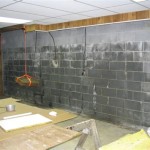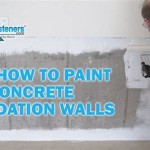How To Repair Cinder Block Basement Walls
Cinder block basement walls, also known as concrete masonry unit (CMU) walls, are a common foundation type in many structures. While durable, these walls are susceptible to damage over time due to factors like moisture intrusion, soil pressure, and age. Identifying and addressing issues promptly is crucial to maintain the structural integrity of the building and prevent more extensive, costly repairs in the future. This article provides a comprehensive guide on how to repair cinder block basement walls, detailing the necessary steps and considerations for a successful project.
Identifying Common Problems in Cinder Block Basement Walls
Before initiating any repair work, a thorough inspection of the cinder block basement walls is essential to pinpoint the specific problems. Common issues include cracks, efflorescence, bowing, and spalling. Each of these problems indicates different underlying causes and requires specific repair strategies.
Cracks represent one of the most prevalent issues. They can range from hairline fractures to significant structural cracks. Hairline cracks, often less than 1/8 inch wide, may be caused by minor settling or shrinkage of the concrete. Larger cracks, particularly those wider than 1/4 inch or running diagonally, can indicate more serious structural problems related to foundation movement or soil pressure. It is crucial to determine the nature and extent of the cracking before proceeding.
Efflorescence, a white, powdery deposit on the wall surface, is a sign of moisture intrusion. Water seeps through the cinder blocks, dissolves salts within the material, and deposits them on the surface as it evaporates. While efflorescence itself is not structurally damaging, it indicates an underlying moisture problem that can lead to more severe issues like deterioration of the cinder blocks and mold growth.
Bowing occurs when the wall bends inward due to excessive hydrostatic pressure from the surrounding soil. This pressure can be exacerbated by poor drainage, saturated soil conditions, or expansive clay soils. Bowing walls pose a significant structural threat and require immediate attention. The severity of bowing is usually measured by the amount of inward deflection, with more severe bowing indicating a greater risk of collapse.
Spalling refers to the crumbling or flaking of the cinder block surface. This is often caused by repeated freezing and thawing cycles, where water penetrates the block, freezes, expands, and weakens the material. Spalling can also result from the use of de-icing salts near the foundation or from chemical reactions within the concrete itself. The impact of spalling affects the aesthetic value of the wall and compromises structural integrity.
Preparing for the Repair Process
Once the problems have been identified and assessed, the next step is preparing for the repair process. This involves gathering the necessary tools and materials, ensuring proper safety precautions, and addressing any underlying causes of the damage.
The tools and materials required will vary depending on the type of repair being performed. For crack repair, typical materials include crack injection epoxy or polyurethane foam, a wire brush, a chisel, a hammer, a mixing container, and a trowel. For patching spalled areas, materials such as hydraulic cement, a patching compound, a mixing container, a trowel, and a sponge are needed. For addressing moisture issues, waterproofing membranes, drainage matting, and a sump pump may be required. It is vital to use materials specifically designed for masonry repair to ensure compatibility and durability.
Safety precautions are paramount throughout the repair process. Wearing safety glasses, gloves, and a dust mask is essential to protect against dust, debris, and chemical exposure. If power tools are used, such as grinders or concrete saws, ear protection and a respirator are also recommended. Ensuring adequate ventilation is also important, especially when working with epoxy or other chemicals that may emit fumes. Proper scaffolding or ladders should be used to safely access high areas of the wall.
Addressing the underlying causes of the damage is crucial for long-term success. If moisture intrusion is the primary problem, identifying and correcting the source of the water is essential. This may involve improving exterior drainage by grading the soil away from the foundation, cleaning gutters and downspouts, or installing a French drain. For bowing walls, it may be necessary to excavate around the foundation and install reinforcement, such as carbon fiber straps or steel beams, to counteract the soil pressure. Ignoring the underlying causes will likely result in the recurrence of the problems, negating the repair efforts.
Step-by-Step Repair Procedures
The specific repair procedures will depend on the type and severity of the damage. Outlined below are general guidelines for repairing common issues such as cracks, efflorescence, bowing, and spalling. However, consulting with a qualified structural engineer or contractor is recommended for complex or severe cases.
Repairing Cracks: For hairline cracks, cleaning the surface with a wire brush to remove any loose debris and applying a masonry crack sealant may be sufficient. The sealant should be applied according to the manufacturer's instructions, ensuring proper coverage and adhesion. For larger cracks, crack injection epoxy or polyurethane foam is often used. The process involves cleaning the crack, installing injection ports along the crack length, and injecting the epoxy or foam under pressure. The injected material fills the crack, bonding the concrete together and preventing further water intrusion. After the epoxy or foam has cured, the injection ports are removed, and the surface is patched with a cement-based patching compound.
Removing Efflorescence: Efflorescence can be removed by dry brushing the affected area with a stiff brush. For stubborn deposits, a diluted solution of muriatic acid or a commercial efflorescence cleaner can be used. It is important to follow the manufacturer's instructions carefully and wear appropriate safety gear when working with chemicals. After cleaning, rinse the area thoroughly with water to remove any residual chemicals. To prevent future efflorescence, addressing the underlying moisture problem is crucial, as previously mentioned.
Addressing Bowing Walls: Bowing walls require significant structural intervention. One common method involves installing carbon fiber straps. The straps are bonded to the wall using an epoxy adhesive and anchored to the foundation and floor joists. The carbon fiber provides additional tensile strength, preventing further bowing. Another method involves installing steel beams vertically against the wall, anchored to the floor and ceiling. The beams act as a support system, resisting the inward pressure. In severe cases, it may be necessary to excavate around the foundation and rebuild the wall or pour a new reinforced concrete wall against the existing one. These repairs should only be performed by experienced professionals.
Patching Spalled Areas: To repair spalled areas, first remove any loose or crumbling concrete with a chisel and hammer. Clean the area thoroughly with a wire brush to remove any debris. Dampen the area with water to improve adhesion. Mix hydraulic cement or a concrete patching compound according to the manufacturer's instructions. Apply the patching material to the spalled area, filling it completely and feathering the edges to blend with the surrounding surface. Use a trowel to smooth the surface and create a consistent texture. Keep the patched area moist for several days to allow the patching material to cure properly. This can be done by covering it with plastic sheeting or misting it with water periodically.
Following these steps will help ensure that the cinder block basement walls are properly repaired, preventing further damage and maintaining the structural integrity of the building. Remember to prioritize safety and consult with professionals when necessary. Regular inspections and preventative maintenance can help prevent the recurrence of problems and extend the lifespan of the foundation.

Fixing A Block Foundation Brigden On Youtube

Cracked Block Foundation Wall Repair Fairfax Contractor

What To Do About This Damaged Concrete Block Foundation Fine Homebuilding

Cracks In Cinder Block Basement Walls

What To Do About Basement Wall Cracks Bq Basements Concrete

Cracked Block Foundation Repair Jes

Stabilizing A Concrete Block Foundation Wall Works

When You Should Replace Your Bowing Cinder Block Foundation Wall Chicago Il Stablwall

Masonry 101 How To Repair A Concrete Cinder Block Wall The Kim Six Fix

How To Repair Your Concrete Foundation That S Crumbling







